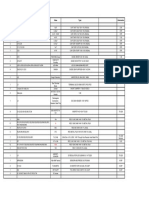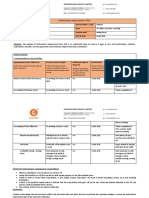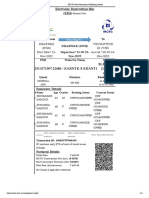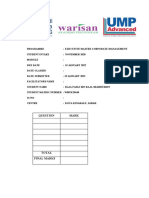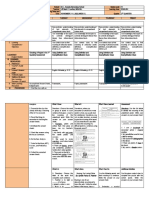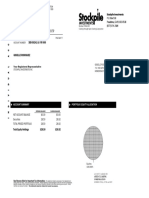Cambridge IGCSE™: Mathematics 0580/41 May/June 2022
Cambridge IGCSE™: Mathematics 0580/41 May/June 2022
Uploaded by
Sarah SiddiquiCopyright:
Available Formats
Cambridge IGCSE™: Mathematics 0580/41 May/June 2022
Cambridge IGCSE™: Mathematics 0580/41 May/June 2022
Uploaded by
Sarah SiddiquiOriginal Title
Copyright
Available Formats
Share this document
Did you find this document useful?
Is this content inappropriate?
Copyright:
Available Formats
Cambridge IGCSE™: Mathematics 0580/41 May/June 2022
Cambridge IGCSE™: Mathematics 0580/41 May/June 2022
Uploaded by
Sarah SiddiquiCopyright:
Available Formats
Cambridge IGCSE™
MATHEMATICS 0580/41
Paper 4 (Extended) May/June 2022
MARK SCHEME
Maximum Mark: 130
Published
This mark scheme is published as an aid to teachers and candidates, to indicate the requirements of the
examination. It shows the basis on which Examiners were instructed to award marks. It does not indicate the
details of the discussions that took place at an Examiners’ meeting before marking began, which would have
considered the acceptability of alternative answers.
Mark schemes should be read in conjunction with the question paper and the Principal Examiner Report for
Teachers.
Cambridge International will not enter into discussions about these mark schemes.
Cambridge International is publishing the mark schemes for the May/June 2022 series for most
Cambridge IGCSE, Cambridge International A and AS Level and Cambridge Pre-U components, and some
Cambridge O Level components.
This document consists of 13 printed pages.
© UCLES 2022 [Turn over
0580/41 Cambridge IGCSE – Mark Scheme May/June 2022
PUBLISHED
Generic Marking Principles
These general marking principles must be applied by all examiners when marking candidate answers. They should be applied alongside the specific content of the
mark scheme or generic level descriptors for a question. Each question paper and mark scheme will also comply with these marking principles.
GENERIC MARKING PRINCIPLE 1:
Marks must be awarded in line with:
the specific content of the mark scheme or the generic level descriptors for the question
the specific skills defined in the mark scheme or in the generic level descriptors for the question
the standard of response required by a candidate as exemplified by the standardisation scripts.
GENERIC MARKING PRINCIPLE 2:
Marks awarded are always whole marks (not half marks, or other fractions).
GENERIC MARKING PRINCIPLE 3:
Marks must be awarded positively:
marks are awarded for correct/valid answers, as defined in the mark scheme. However, credit is given for valid answers which go beyond the scope of the
syllabus and mark scheme, referring to your Team Leader as appropriate
marks are awarded when candidates clearly demonstrate what they know and can do
marks are not deducted for errors
marks are not deducted for omissions
answers should only be judged on the quality of spelling, punctuation and grammar when these features are specifically assessed by the question as
indicated by the mark scheme. The meaning, however, should be unambiguous.
GENERIC MARKING PRINCIPLE 4:
Rules must be applied consistently, e.g. in situations where candidates have not followed instructions or in the application of generic level descriptors.
GENERIC MARKING PRINCIPLE 5:
Marks should be awarded using the full range of marks defined in the mark scheme for the question (however; the use of the full mark range may be limited
according to the quality of the candidate responses seen).
© UCLES 2022 Page 2 of 13
0580/41 Cambridge IGCSE – Mark Scheme May/June 2022
PUBLISHED
GENERIC MARKING PRINCIPLE 6:
Marks awarded are based solely on the requirements as defined in the mark scheme. Marks should not be awarded with grade thresholds or grade descriptors in
mind.
Maths-Specific Marking Principles
1 Unless a particular method has been specified in the question, full marks may be awarded for any correct method. However, if a calculation is required
then no marks will be awarded for a scale drawing.
2 Unless specified in the question, answers may be given as fractions, decimals or in standard form. Ignore superfluous zeros, provided that the degree of
accuracy is not affected.
3 Allow alternative conventions for notation if used consistently throughout the paper, e.g. commas being used as decimal points.
4 Unless otherwise indicated, marks once gained cannot subsequently be lost, e.g. wrong working following a correct form of answer is ignored (isw).
5 Where a candidate has misread a number in the question and used that value consistently throughout, provided that number does not alter the difficulty or
the method required, award all marks earned and deduct just 1 mark for the misread.
6 Recovery within working is allowed, e.g. a notation error in the working where the following line of working makes the candidate’s intent clear.
© UCLES 2022 Page 3 of 13
0580/41 Cambridge IGCSE – Mark Scheme May/June 2022
PUBLISHED
ABBREVIATIONS IN MARK SCHEME
Abbreviation Meaning
M Method marks - for a correct method applied to appropriate numbers.
A Accuracy marks – depend on M marks. Hence M0 A1 is not possible.
B Independent of method marks – for a correct final answer, a partially correct answer or a correct intermediate stage.
SC Marks given in special cases only when indicated in mark scheme.
FT Work can be followed through after an error.
isw Ignore subsequent working (after correct answer obtained)
cao Correct answer only
nfww Not from wrong working
oe Or equivalent
soi Seen or implied
eeo Each error or omission
dep Dependent on the previous mark(s)
© UCLES 2022 Page 4 of 13
0580/41 Cambridge IGCSE – Mark Scheme May/June 2022
PUBLISHED
Question Answer Marks Partial Marks
1(a)(i) 1 7 7 8 8 9 9 2 B1 for one row correctly ordered or for fully correct unordered
stem-and-leaf diagram or for a correct diagram with one error or
2 1 1 1 1 2 3 3 4 5 omission
1(a)(ii) 21 1
1(a)(iii) 23 1
1(a)(iv) 48 2 2 360
M1 for 360 or 2
15 15
1(b)(i) 120 1
1(b)(ii) 130 1
1(b)(iii) 60 1
1(c)(i) 93.4 4 M1 for mid-values soi
M1 for fx
M1 dep on second M for fx 200
1(c)(ii) 19 2 86 114
M1 for or
50 60
Question Answer Marks Partial Marks
2(a) 42 2 M1 for 12 ÷ 2 or better
2(b)(i) 5.72 2 100 12
M1 for 6.50 oe
100
or B1 for 0.88 oe
2(b)(ii) 12.5[0] 2 100 12
M1 for x 11 or better oe
100
© UCLES 2022 Page 5 of 13
0580/41 Cambridge IGCSE – Mark Scheme May/June 2022
PUBLISHED
Question Answer Marks Partial Marks
2(c) 4 2 100 2.5 100 6.6
M1 for [...] oe
100 100
2(d)(i) 72.3 or 72.31... 2 100 2
5
M1 for 80 oe
100
2(d)(ii) 4 nfww 3 B2 for answer 9 nfww
or M2 for correct trials with values giving either side of 67
n
100 2
or M1 for 80 = 67
100
k
100 2
or their i 67
100
or an evaluated trial with n ⩾ 6 or k ⩾ 1
Question Answer Marks Partial Marks
3(a)(i) 6 3 B2 for 4x + 6 = 30 or better
or M1 for x + x + 7 + 2x – 1 [ = 30]
3(a)(ii) 21 3 M2 for (555 – their x 15 – their (x + 7) × 18) ÷ their (2x – 1)
or M1 for their x 15 or their (x + 7) × 18
3(b)(i) 8 2 M1 for isolating the term in w or correctly removing all fractions
3w 1
e.g. 1 or better or 3w – 16 = 8
16 2
3(b)(ii) 3 2 1
M1 for 2 y 8 or 2 y or 2 y their w or better
8
© UCLES 2022 Page 6 of 13
0580/41 Cambridge IGCSE – Mark Scheme May/June 2022
PUBLISHED
Question Answer Marks Partial Marks
3(c)(i) 1 2 B1 for each
[p =] oe [q =] 1 If zero scored, SC1 for 2 values satisfying one of the original
2
equations
3(c)(ii) [u =] 30 and 150 4 B1 for each
[v =] 0 and 360 OR
SC1 for sin u = their p and cos v = their q
SC1 if their two different angles for u sum to 180 or if their
different two angles for v sum to 360
Question Answer Marks Partial Marks
4(a)(i) 3 1
4(a)(ii) 7 1 FT their (i)
3×their (i) 2
4(b) x2 2 y 2
oe final answer M1 for y + 2 = 3x or x or x = 3y – 2
3 3 3
4(c) 25 2 1
M1 for 52 oe
x
4(d) 2 x2 x 1 2 1
final answer M1 for 2x – 1 –
x x
4(e) 2.98 × 1017 or 2.980... × 1017 1
4(f) 625 2 M1 for x = j(4)
© UCLES 2022 Page 7 of 13
0580/41 Cambridge IGCSE – Mark Scheme May/June 2022
PUBLISHED
Question Answer Marks Partial Marks
5(a)(i)(a) 8 2 180 oe
M2
M1 for
8 2 180 or
360
or
2 8 4 90
8 2 8 8 8
5(a)(i)(b) 174 or 173.8.... 4 1
M3 for 6 OM oe
2
1
OA sin45 oe
2
or
2
1
or 6 OA sin67.5 oe
2
where OA and OM are as in the M2
or M2 for OM 3 tan 67.5 oe
3 6 sin67.5
or for OA or oe
cos 67.5 sin45
OM
or M1 for tan 67.5 oe
3
3
or for cos 67.5 oe
OA
sin45 sin67.5
or for oe
6 OA
5(a)(ii) 193 or 193.0 to 193.1 3 3
2
M2 for oe
cos 67.5
3 sin45 sin67.5
or M1 for cos 67.5 or
r 6 r
© UCLES 2022 Page 8 of 13
0580/41 Cambridge IGCSE – Mark Scheme May/June 2022
PUBLISHED
Question Answer Marks Partial Marks
5(b)(i) 1.27 or 1.272 to 1.273 2 1
M1 for 0.452 4
2
1
or 0.452 4
2
5(b)(ii) 742 or 743 6 M5 for a method leading to the volume of water
0.15
invcos
e.g. 4 {2 0.45 0.452
360
1 0.15
0.452 sin 2 invcos } oe
2 0.45
OR
0.15
invcos
M2 2 0.45 0.452 oe
360
0.15
90 invcos
or 2 0.45 0.452 oe
360
or M1 for use of 0.452 oe
360
1 0.15
M2 for 0.452 sin 2 invcos oe
2 0.45
1 0.15
or 0.15 0.45 sin invcos 2 oe
2 0.45
© UCLES 2022 Page 9 of 13
0580/41 Cambridge IGCSE – Mark Scheme May/June 2022
PUBLISHED
Question Answer Marks Partial Marks
5(b)(ii) 1
0.452
or M1 for use of 2 × sinθ oe
1
2 0.15 0.45 sin β
or 2 oe
If 0 scored,
0.15 0.15
SC1 for invcos 0.45 or invsin 0.45
or 0.452 0.152 soi
6(a)(i) –3 1
6(a)(ii) –1 3 B1 for each
1.55 to 1.6
4.4 to 4.45
6(a)(iii) –8 1
6(a)(iv) Ruled line through origin intersecting curve once 2 B1 for ruled line through origin
6(b)(i) 18 3 B2 for 6x – 12
or B1 for 6x or –12
6(b)(ii) (2, –5) 2 B1 for each.
If 0 scored, M1 for their 6x – 12 = 0
dy
or states 0
dx
6(c) [p = ] 7 2 B1 for each
[q = ] 3
© UCLES 2022 Page 10 of 13
0580/41 Cambridge IGCSE – Mark Scheme May/June 2022
PUBLISHED
Question Answer Marks Partial Marks
7(a) 39.6 or 39.57.... 4 142 122 92
M2 for [cos =]
2 14 12
or M1 for 92 = 142 + 122 – 2 × 14 × 12 × cos ACD
37
A1 for 0.7708... or 0.771 or oe
48
7(b) 14sin 25 M2 sin123 sin 25
M1 for oe
sin123 14 BC
7.054… A1
7(c) 3.74 or 3.735 to 3.739 3 M2 for 7.05 × sin 32
or M1 for recognition that the line from B is perpendicular to AC
7(d) 11.8 or 11.83 to 11.85 4 M1 for 32 + their(a) soi
M2 for
122 7.052 2 12 7.05 cos(their a 32)
122 7.052 BD 2
or M1 for cos their a 32
2 12 7.05
7(e) 309.6 or 309.57... 2 FT 270 + their(a)
M1 for 270 + their(a) oe
© UCLES 2022 Page 11 of 13
0580/41 Cambridge IGCSE – Mark Scheme May/June 2022
PUBLISHED
Question Answer Marks Partial Marks
8(a)(i) A B 1
8(a)(ii) 2 B1 for each
8(b)(i) 9 1
11
8(b)(ii) 36 3 2 9
oe M2 for 2 oe
121 11 11
2 9
or M1 for oe
11 11
36
If 0 scored SC1 for
110
8(c)(i) 3, 5, 28, 14 correctly placed 2 B1 for 28 in the intersection
8(c)(ii) 28 1 FT their 28 where their 28 50
oe
50
8(c)(iii) 123 2 42 41
oe M1 for
175 50 49
8(c)(iv) 63 2 FT their 28
oe
88 their 28 their 28 1
M1 for
33 32
© UCLES 2022 Page 12 of 13
0580/41 Cambridge IGCSE – Mark Scheme May/June 2022
PUBLISHED
Question Answer Marks Partial Marks
9(a) x 2 x 30 0 B3 M1 for (2 x 1)( x 1) x 2 29 oe
B1 for (2 x 1)( x 1) 2 x 2 2 x x 1 oe soi
x 6 x 5 oe M1 or correct factors for their 3 term quadratic equation
or for correct substitution into quadratic formula or correctly
completing the square for their 3 term quadratic equation
x 6 cao B1
12 or 2 × their x evaluated B1 FT
or k 2 x stated
9(b)(i) y 1 M1
3
y 3 5 oe
y 1 B2 B1 for y 12 y 2 y y 1 oe soi
3
y 3 3 y 2 3 y 1 soi
Completion to 3y2 + 3y – 4 = 0 A1 With no errors or omissions
9(b)(ii) 3 32 4(3)(4) B2 or B1 for 32 4(3)(4)
23 3 ... 3 ...
or for or
23 23
0.44 B2 B1 for 0.758 or 0.7583...
© UCLES 2022 Page 13 of 13
You might also like
- PDF Created With Pdffactory Pro Trial VersionDocument11 pagesPDF Created With Pdffactory Pro Trial VersionK venkata ramana71% (14)
- 2085 Hart MoDem DatasheetDocument8 pages2085 Hart MoDem DatasheetHPC HartNo ratings yet
- Speeduino 0.4.3C Part ListDocument1 pageSpeeduino 0.4.3C Part ListRicardo LealNo ratings yet
- Application Form - Campus HiringDocument5 pagesApplication Form - Campus HiringDhanu T ANo ratings yet
- Time To Achieving A Designated Criterion Score Level: A Survival Analysis Study of Test Taker Performance On The Toefl Ibt TestDocument23 pagesTime To Achieving A Designated Criterion Score Level: A Survival Analysis Study of Test Taker Performance On The Toefl Ibt TestSANSNo ratings yet
- Math1014 Sample Final ExamDocument12 pagesMath1014 Sample Final ExamPatrick TangNo ratings yet
- Capstone Final Report - Natural Disaster App - FinalDocument32 pagesCapstone Final Report - Natural Disaster App - Finalapi-498485959No ratings yet
- Merck Photocatalysis ChartDocument1 pageMerck Photocatalysis ChartRagav GNo ratings yet
- CloudTrax - Quick Start GuideDocument8 pagesCloudTrax - Quick Start GuideSubang Jaya Youth ClubNo ratings yet
- 24.03.22 SR - Star Co-Sc Jee Main Gtm-6 QPDocument20 pages24.03.22 SR - Star Co-Sc Jee Main Gtm-6 QPok computersNo ratings yet
- Compal Confidential: UMA MB Schematic Document Eh7Lw/Eh5Lw/Fh5Tw/Eh7Lc/Eh5LcDocument46 pagesCompal Confidential: UMA MB Schematic Document Eh7Lw/Eh5Lw/Fh5Tw/Eh7Lc/Eh5LcAlisson PereiraNo ratings yet
- March 1st 2023Document16 pagesMarch 1st 2023MD ALTAMASH KHALIDNo ratings yet
- Grofers - PIP Form Niraj ShahDocument3 pagesGrofers - PIP Form Niraj ShahStuti GaurNo ratings yet
- Significant FiguresDocument5 pagesSignificant Figuresdedo DZ100% (1)
- Introduction To HVAC&R Systems: Ir. Dr. Sam C. M. HuiDocument48 pagesIntroduction To HVAC&R Systems: Ir. Dr. Sam C. M. HuiJerry ChanNo ratings yet
- Focus1 2E Test Unit7 GroupA 1kolDocument6 pagesFocus1 2E Test Unit7 GroupA 1kolKarolina PelcNo ratings yet
- Placement Report For Cohort of 2022 Masters Union 1669642023Document22 pagesPlacement Report For Cohort of 2022 Masters Union 1669642023Dharun SNo ratings yet
- IRCTC Next Generation Eticketing SystemDocument4 pagesIRCTC Next Generation Eticketing SystemSamarth HandurNo ratings yet
- IS516 Part1 Sec1 2021Document20 pagesIS516 Part1 Sec1 2021Manoj Kumar SinghNo ratings yet
- Raja Fadhli - Business LawDocument5 pagesRaja Fadhli - Business LawShaleeena AiharaNo ratings yet
- Sensors 23 06430Document18 pagesSensors 23 06430r.shekara22No ratings yet
- Gmail - Booking Confirmation On IRCTC, Train - 14008, 25-Nov-2021, 2S, ANVT - SLNDocument1 pageGmail - Booking Confirmation On IRCTC, Train - 14008, 25-Nov-2021, 2S, ANVT - SLNchandan tiwariNo ratings yet
- BM 2024 I 001786196Document6 pagesBM 2024 I 001786196Sahil SharmaNo ratings yet
- Equity Portfolio Sample - LH - S2 2021Document20 pagesEquity Portfolio Sample - LH - S2 2021ng kelvinNo ratings yet
- Digital Economy and Sustainable Use of Resources A Case Study of Saudi ArabiaDocument9 pagesDigital Economy and Sustainable Use of Resources A Case Study of Saudi ArabiaInternational Journal of Advance Study and Research WorkNo ratings yet
- DLL - English 4 - Q2 - W1Document6 pagesDLL - English 4 - Q2 - W1Toto Toto100% (1)
- Rams at HuntersDocument3 pagesRams at Hunterschristopher_wright_homeNo ratings yet
- DSO Service Credits Teaching 2Document35 pagesDSO Service Credits Teaching 2CHANIELOU MARTINEZNo ratings yet
- Material Selection For AlloyDocument8 pagesMaterial Selection For AlloyOscarNo ratings yet
- Application Form For Registration As Authorised Collection Center (ACC)Document2 pagesApplication Form For Registration As Authorised Collection Center (ACC)rohigoyal100% (1)
- (1-14) Study On Individual's Preference About Online Cab Booking ServicesDocument14 pages(1-14) Study On Individual's Preference About Online Cab Booking ServicesKartik RajputNo ratings yet
- مقاومه مواد محاضرات د.فراتDocument121 pagesمقاومه مواد محاضرات د.فراتlana_salahadinNo ratings yet
- Accounting Concepts - BasicDocument37 pagesAccounting Concepts - BasicMary ANo ratings yet
- CGPSC Assistant Professor 2019 PhysicsDocument36 pagesCGPSC Assistant Professor 2019 PhysicsSAHIN InspireNo ratings yet
- Financial Statement Analysis Chapter 13Document65 pagesFinancial Statement Analysis Chapter 13Rupesh PolNo ratings yet
- Ar 2023-176Document3 pagesAr 2023-176Alaska's News SourceNo ratings yet
- Moxa Nport W2150a W2250a Series Manual v10.2Document142 pagesMoxa Nport W2150a W2250a Series Manual v10.2gfdgfNo ratings yet
- 63 BD 111532 Ee 3113 RD Bo AAgenda SEZwDocument39 pages63 BD 111532 Ee 3113 RD Bo AAgenda SEZwGIFT CityNo ratings yet
- WMSU Lec5 OHealthDocument63 pagesWMSU Lec5 OHealthKaiser CarloNo ratings yet
- 30-Apr-2022 06-Mar-2023 20-Apr-2023 1100 Hrs - 1400 HrsDocument3 pages30-Apr-2022 06-Mar-2023 20-Apr-2023 1100 Hrs - 1400 HrssapramyaNo ratings yet
- Group Personal Accident-Claim FormDocument4 pagesGroup Personal Accident-Claim FormVipul SharmaNo ratings yet
- Syllabus Economics Second CycleDocument40 pagesSyllabus Economics Second CycleEwane yvaud EmbeNo ratings yet
- Apprenticeship Opportunity View - Apprenticeship Training PortalDocument2 pagesApprenticeship Opportunity View - Apprenticeship Training PortalramNo ratings yet
- Document 1312021 53807 AM ZrAxTn7pDocument8 pagesDocument 1312021 53807 AM ZrAxTn7pGisselle RodriguezNo ratings yet
- Electronic Reservation Slip (ERS) : Passenger DetailsDocument2 pagesElectronic Reservation Slip (ERS) : Passenger DetailsrajendranrajendranNo ratings yet
- Ipru Pension 10 Year X 2 LacDocument5 pagesIpru Pension 10 Year X 2 LacHK Option LearnNo ratings yet
- Mtech Cloud Computing BrochureDocument15 pagesMtech Cloud Computing BrochureMANISH KUMARNo ratings yet
- Market and MarketinDocument20 pagesMarket and MarketinMohamad El AyoubiNo ratings yet
- Cambridge International AS & A Level: Computer Science 9618/12Document16 pagesCambridge International AS & A Level: Computer Science 9618/12AcidNo ratings yet
- Non Ideal BehaviorDocument9 pagesNon Ideal BehaviorTushar DaveNo ratings yet
- 1 s2.0 S0920410521010251 MainDocument22 pages1 s2.0 S0920410521010251 MainYermek SanaliNo ratings yet
- GXT 225R Mobile Shear: Parts ManualDocument53 pagesGXT 225R Mobile Shear: Parts ManualPrudzNo ratings yet
- Computer Architecture: Assoc. Prof. Nguyễn Trí Thành, PhdDocument51 pagesComputer Architecture: Assoc. Prof. Nguyễn Trí Thành, Phdpham mai linhNo ratings yet
- User Manual: GX-SM530SLDocument60 pagesUser Manual: GX-SM530SLYayan cahyadiNo ratings yet
- TWP MQ877955 PDFDocument3 pagesTWP MQ877955 PDFShubham SamantaNo ratings yet
- Fall 2022 - CS201P - 1Document2 pagesFall 2022 - CS201P - 1Rana King AliNo ratings yet
- Basic Network - Server KhmerDocument214 pagesBasic Network - Server KhmerBut DalinNo ratings yet
- Business Finance II: Course Title: Course ID: FIN302 Section: 02 Semester: Spring, 2022Document25 pagesBusiness Finance II: Course Title: Course ID: FIN302 Section: 02 Semester: Spring, 2022gaja babaNo ratings yet
- Letter of Intent Date: 18-Feb-2019 Mr. Ravi Mishra,: For Multiplier Brand Solutions PVT LTDDocument2 pagesLetter of Intent Date: 18-Feb-2019 Mr. Ravi Mishra,: For Multiplier Brand Solutions PVT LTDRavi MishraNo ratings yet
- Business Mathematics 1631124113Document468 pagesBusiness Mathematics 1631124113Mushif JathoolNo ratings yet
- ADHD Symptomatology Is Best Conceptualized As A SpectrumDocument21 pagesADHD Symptomatology Is Best Conceptualized As A SpectrumMatheus PrenassiNo ratings yet
- June 2022 (v1) Ms - Paper 4 Caie Maths IgcseDocument13 pagesJune 2022 (v1) Ms - Paper 4 Caie Maths IgcseUmmul BaneenNo ratings yet
- 34 Multiple MeaningWordsDocument3 pages34 Multiple MeaningWordsKriztaleen Pertz LptNo ratings yet
- Aeroness Weekly Report Up To-18 Oct MEP-AI-WR-068Document10 pagesAeroness Weekly Report Up To-18 Oct MEP-AI-WR-068Bangla DeshNo ratings yet
- Sulfex-Communication effectiveness-NASIRA KPDocument57 pagesSulfex-Communication effectiveness-NASIRA KPPrabiNo ratings yet
- PCT Unit II - Units and MeasurementsDocument32 pagesPCT Unit II - Units and MeasurementsEuna De GuzmanNo ratings yet
- F4 SuppEx1Document3 pagesF4 SuppEx1Queenie LaiNo ratings yet
- Leadership and Management at Ford Vietnam CompanyDocument8 pagesLeadership and Management at Ford Vietnam CompanyAnh Su Dieu MinhNo ratings yet
- Lab 1. Experiment 2. Fluid Properties: ViscosityDocument2 pagesLab 1. Experiment 2. Fluid Properties: ViscosityPapi JackNo ratings yet
- Table of Specifications in Mathematics 4Document7 pagesTable of Specifications in Mathematics 4Maria Reca Ligue SantaceraNo ratings yet
- GPS Leica-Rx1200 ManualDocument210 pagesGPS Leica-Rx1200 ManualalejoelingNo ratings yet
- Graph-Based Clustering and Data Visualization AlgorithmsDocument1 pageGraph-Based Clustering and Data Visualization AlgorithmsJorge A Parraga ANo ratings yet
- Compurt FundamentalDocument12 pagesCompurt FundamentalDondapati SaipradeepchowdaryNo ratings yet
- Open Source and Proprietary SoftwareDocument3 pagesOpen Source and Proprietary SoftwareRoselle Dioso SorianoNo ratings yet
- An Assessment of Farmers Pastoralists CoDocument17 pagesAn Assessment of Farmers Pastoralists CoIsehunwa Moses AbayomiNo ratings yet
- Apes 5900Document2 pagesApes 5900Marco AlfieriNo ratings yet
- Human Collective Aggression: A Behavioral Ecology PerspectiveDocument16 pagesHuman Collective Aggression: A Behavioral Ecology PerspectiveHector RafaelNo ratings yet
- Digital Services Governance Recommendations: Supporting Implementation of Digital Services Governance Structures in The Federal GovernmentDocument42 pagesDigital Services Governance Recommendations: Supporting Implementation of Digital Services Governance Structures in The Federal GovernmentFedScoop100% (1)
- BSIMM V ActivitiesDocument32 pagesBSIMM V ActivitiesmabesninaNo ratings yet
- Association Rules PDFDocument35 pagesAssociation Rules PDFRenphilIanGapasBalantinNo ratings yet
- LEGO Group: Article by Mark Stafford Photos From Niels Milan Pedersen's Personal LEGO ArchivesDocument6 pagesLEGO Group: Article by Mark Stafford Photos From Niels Milan Pedersen's Personal LEGO ArchivesMatthew WhiteNo ratings yet
- Helen Van Anderson - The Mystic Scroll, Book of Revelations 1906Document248 pagesHelen Van Anderson - The Mystic Scroll, Book of Revelations 1906Waterwind100% (1)
- Ba Sample ProfileDocument4 pagesBa Sample ProfileSamule PaulNo ratings yet
- C Prog - 2 PDFDocument9 pagesC Prog - 2 PDFAlisha AgarwalNo ratings yet
- Biomaterials For OrthopedicsDocument26 pagesBiomaterials For OrthopedicsAbdul Majeed SsmNo ratings yet
- Analysing Spatio-Temporal Regression Data: A Case Study in Forest HealthDocument43 pagesAnalysing Spatio-Temporal Regression Data: A Case Study in Forest HealthHoàng Thanh TùngNo ratings yet
- Weekend Homework Actively LearnDocument2 pagesWeekend Homework Actively Learndeniz.mila.gencNo ratings yet
- 8051 CH8Document42 pages8051 CH8Usama JavedNo ratings yet
- Stubbs, K.M., 2023. Narratives in Subjective Performance Evaluations Do Ratings Change The NarrativeDocument17 pagesStubbs, K.M., 2023. Narratives in Subjective Performance Evaluations Do Ratings Change The NarrativekiesoakmNo ratings yet
- CHONG Alecs KT - PHD ThesisDocument369 pagesCHONG Alecs KT - PHD ThesisaktcNo ratings yet


